Aaron A. Rosenthal
(1863 Hornitos, CA - 23 Dec 1928 Portland, Oregon)
My Great Uncle
Part 2: 1900-1928
Introduction
Very little is known of Aaron Rosenthal as far as his personality or activities. He lived most of his adult life (1884-1928) in Portland Oregon and worked as a clerk for several companies there. Why he went to Portland, I can only speculate. Perhaps he had relatives or friends who belonged to the Volga German community there. Perhaps he was a professional gambler (an honorable profession in those days) whose travels took him there. I have decided to follow Aaron by his timeline and addresses to get a picture of where he walked and what events he was aware through his life.
1900 Age: 37 28 Cambridge Building, Portland, Oregon, USA Rosenthal & Budd
Francis Andrew "Frank" Palmer's barber shop on 2nd in Old Town Portland, Oregon, circa 1900
1901 Age: 38 28 Cambridge Building, Portland, Oregon, USA Rosenthal & Budd
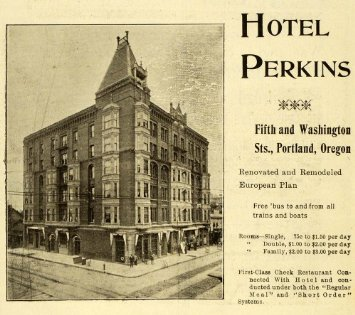
1901 Ad Hotel Perkins Portland Oregon Travel Tour Train - Original Print Ad
1902 Age: 39 28 Cambridge Building, Portland, Oregon, USA Rosenthal & Budd
August 26, 1902: Buffalo Bill’s Wild West Makes Oregon Debut
The first Oregon appearance of the Buffalo Bill’s Wild West show took place on August 26, 1902 in Northwest Portland (The Morning Oregonian, 27 August 1902
There were thrilling times at the Wild West show yesterday. For two hours before the gates opened people were blackening the streets that lead to the big tents, at Twenty-first and Savier streets. Good nature reigned, despite the heat and the dust. And as a reward the strong men who managed to pilot their families in were entranced and spellbound for two hours by an exhibition of nerve, skill and manly strength. Those whom long years in office and at desks had enervated woke to the knowledge of their birthright of physical vigor and activity, and the many plainsmen and miners and ranchers who thronged in every section glowed with the feeling that this was almost the apotheosis of their own deeds.
The “Wild West” themed circus-like show was popular at the turn of the last century, touring the country and the world, showcasing Western and American Indian cultures, horsemanship, sharp shooting, and dubious re-enactments of historical battles and Indian vs. Cowboy encounters.
1903 Age: 40 Cambridge Building, Portland, Oregon, USA Clerk for Julius Wertheimer
It was announced that the upstart Pacific Coast League (PCL), which was to start in 1903, would have a franchise in Portland. The "Browns" was selected for the team's nickname, but it is unclear by whom. The Oregonian criticized the name, writing that it gave the team bad luck.[1] J. P. Marshall served as the team's president and J. C. Ainsworth was the treasurer.
In 1903, Portland was represented by two baseball teams; the Browns of the PCL and thePortland Greengages of the Pacific National League (PNL)

Members of the Portland Browns in 1903, from left to right: Dennie Shea, Wallace Hollingsworth, Phil Nadeau, Andy Anderson, Ike Francis, Ike Francis, Joe Raidy, Charlie Shields, Dan McFarlan, Sammy Vigneaux, Deacon Van Buren, Harry Blake, and Jake Fender.
The Browns warming-up before a game in 1903.
1904 - 1907 Age: 41 Gem Club, 127 1/2 6th Street, Portland, Oregon, owner of gambling house. See news articles for more info. Knight of the Green Cloth Portland,
The Players in the Gem Club’s Troubles
Herman “Patsy” Elkies, “Irish” Young, Martin Reddy were Aaron Rosenthal’s partners
Portland House, 134 5th Street, Gem’s competitor. The local gambling octopus headed by Portland House helped close the Gem, to have a monopoly
Chief of Police Hunt
 Mayor Williams: George Henry Williams (March 26, 1823 - April 4, 1910) was an American judge and politician. He served as Chief Justice of the Oregon Supreme Court, was the 32nd Attorney General of the United States, and was elected Oregon's U.S. Senator, and served one term. Williams, as U.S. Senator, authored and supported legislation that allowed the U.S. military to be deployed in Reconstruction southern states to allow for an orderly process of readmittance into the United States. Williams was the first presidential Cabinet member to be appointed from the Pacific Coast.
Mayor Williams: George Henry Williams (March 26, 1823 - April 4, 1910) was an American judge and politician. He served as Chief Justice of the Oregon Supreme Court, was the 32nd Attorney General of the United States, and was elected Oregon's U.S. Senator, and served one term. Williams, as U.S. Senator, authored and supported legislation that allowed the U.S. military to be deployed in Reconstruction southern states to allow for an orderly process of readmittance into the United States. Williams was the first presidential Cabinet member to be appointed from the Pacific Coast.
Williams returned to Oregon, resumed private law practice, and was elected Portland's mayor having served two terms from 1902 to 1905. Williams advocated women’s suffrage and that marriage and divorce proceedings needed to be handled by the civil courts rather then the church. Williams, at the age of 83, was indicted while Mayor of Portland for not enforcing gambling restriction statutes; although he was acquitted and served out the rest of his term as Mayor.
The Gem Saloon and Oro Fino Saloon and Theater, located on First Street between Oak and Stark, in 1876. The Oro Fino was half owned by Portland's city police chief, Edouard Chambreau's old gold-field gambling crony James Lappeus. (Image: Oregon Historical Society)
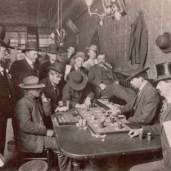
Gamblers
The Frontier Gambler is one of the most recognizable stock characters of the American West, usually portrayed as a gentlemanly southerner living outside of the law. Historically, gamblers were of both sexes, came from a variety of professions and class backgrounds, were of many different nationalities, and were part of a well-respected profession. As the west became increasingly populated and domesticated, the public perception of gambling changed to a negative one and led nearly all of the state and territorial legislatures to pass anti-gambling laws in and effort to "clean up" their towns.
The heyday of gambling in the west lasted from 1850-1910. Gambling was the number one form of entertainment in the west and nearly everyone living there engaged in it at one time or another. Cowboys, miners, lumberjacks, businessmen, and lawmen all played games of chance for pleasure and profit. Whenever a new settlement or camp started one of the first buildings or tents erected would be a gambling hall. As the settlement grew, these halls would become larger and more elaborate in proportion. Gaming halls were typically the largest and most ornately decorated buildings in any town and often housed a bar, stage for entertainment, and hotel rooms for guests. These establishments were a driving force behind the local economy and many towns measured their prosperity by the number of gambling halls and professional gamblers they had. Towns that were friendly to gaming were typically known to sports as "wide-awake" or "wide-open" for their acceptance of gambling.

Most western citizens considered gambling to be a respectable profession and those who chose to make a living doing it were respected members of society. "Gambling was not only the principal and best paying industry of the town at the time, but it was also reckoned among its most respectable," wrote Bat Masterson in 1907. Professional gamblers ran their own games by renting a table at a gambling house and banking it with their own money. Because of this, many professional gamblers settled in one place and in order to be successful as an established businessman, a gambler needed cultivate a reputation for fairness and running a straight game. These men were known as sports and did not drink, cheat, or swear, paid rent and licensing fees, encouraged customers to run up bar tabs, and did their best to act as historian Hubert Hoover Bancroft put it, "reputable and respectable merchants."
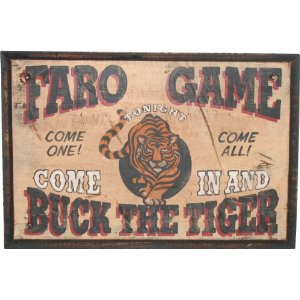
Pharaoh, shortened to "Faro" quickly made its way to the United States in the 19th century to become the most widespread and popularly favored of gambling games. Faro is also called "Bucking the Tiger", which it is believed, comes from early card backs that featured a drawing of a Bengal Tiger.
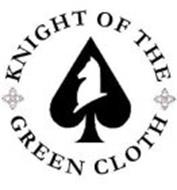
Knights of the Green Cloth: Gamblers preferred fast-paced games allowed them an opportunity to turn a profit quickly. Faro was the most popular game of the time and was known as the king of all games. It was not the only game people played, and monte, Vingt-et-Un (twenty-one), roulette, chuck-a-luck were all popular ways to take a risk. Poker was not initially popular because of its slow pace but gradually increased in popularity as time went on.
Monte Bank, Mountebank, Spanish Monte and Mexican Monte, sometimes just Monte, is a Spanish gambling card game and the national card game of Mexico. It ultimately derives from basset, where the banker (dealer) pays on matching cards. The term "monte" has also been used for a variety of other gambling games, especially varieties of three-card poker, and for the swindle three-card monte. According to JD Borthwick, Indians always disposed of their money in two ways: playing "Monte" with Mexicans and purchasing articles of clothing
1905 Age: 42 Cambridge Building, Portland, Oregon, USA Clerk for Julius Wertheimer

Downtown Portland in 1905, looking east on S.W. Morrison from S.W. Third.
1906 Age: 43 Cambridge Building, Portland, Oregon, USA Clerk for Julius Wertheimer

An afternoon scene on Sixth Street, deep in the "respectable" part of town. The closest building is the posh and comfortable Portland Hotel, and the clock tower behind is the Oregonian building. This image comes from a postcard which was postmarked 1906.
1907 Age: 44 Cambridge Building, Portland, Oregon, USA Clerk for Julius Wertheimer
Four Portland Oregon churches in the fabulous & very popular Art Nouveau style, the card pictures these churches: Trinity Episcopal Church; New Catholic Church, East Side; St. James Lutheran Church; and White Temple, Twelfth & Taylor Streets, First Baptist.
1910 Age: 47 165 1/2 3rd, Portland, Oregon, USA Clerk
City & Suburban Railway, SW Third & Yamhill Streets
Gradually, however, they clustered just north of Burnside Street, from Second Street out to the Park blocks. They found their entertainment in vaudeville houses, beer gardens, and saloons. The unattached young men created income for pool halls, frequented saloons and their accompanying brothels, and became the focus of law enforcement. But they also filled the city’s treasury, because license fees, especially for the saloons, provided the bulk of the city’s regular income. The police, however, now felt Portland had become a real city with its own criminal district to patrol. In 1880 most crimes were committed in a corridor from “D” Street on the north to Morrison Street on the south, and between Fourth Street and east Oak, with the heaviest cluster between A and Stark streets. Of those arrested, 25 percent were of Irish birth, while only 5 percent were Chinese.
Portland’s center for prostitution was just south of the designated high crime area, on Third Street near Yamhill. A string of twelve small houses was interspersed between numbers 110 and 191 along Third, with five additional houses along Yamhill between First and Third streets.
1911 Age: 48 264 Morrison, Portland, Oregon, USA Clerk, Imperial Cigar Company
Corner of SW Morrision and Sixth
Portland’s center for prostitution was just south of the designated high crime area, on Third Street near Yamhill. A string of twelve small houses was interspersed between numbers 110 and 191 along Third, with five additional houses along Yamhill between First and Third streets. All fifty-eight women designated as prostitutes in the 1880 federal manuscript census were white, and almost two-thirds were age twenty-five or younger, including thirteen teen-age girls. Many of the prostitutes were attended by young Chinese men, who cooked, ran their errands, and took their sheets to nearby laundries. Prostitution was accepted as part of downtown life by the wealthiest real estate investors, who owned the properties on which the houses were located. Harold Hirsch, the great nephew of Jeannette Meier, recalled that the department store considered the prostitutes among their most reliable customers for linens, because they always paid in cash.
1912 Age: 49 264 1/2 Morrison, Portland, Oregon, USA Clerk, Imperial Cigar Company

( HARLEY DAVIDSONS PORTLAND, OREGON, 1912 )
1913 Age: 50 411 1/2 Burnside, Portland, Oregon, USA Hotel La Salle
PORTLAND, OREGON - December 04, 2013 - Chef David Diffendorfer spent time researching the buildings at the Oregon Historical Society for the Benson Hotel's annual gingerbread display. The creation began in September and involved 500 hours of work. Stephanie Yao Long/The Oregonian
1914 Age: 51 411 1/2 Burnside, Portland, Oregon, USA Hotel La Salle
Waterfront - foot of Yamhill and Salmon Sts., c. 1914
Once the original hub of the business district, Yamhill has witnessed floods, fires, prosperity and slumps. This history will document the major developments which have occurred in the district since it's days as being part of the clearing until present, and the effect those developments have had on the area."
1915 Age: 52 Portland, Oregon, USA
The Portland Railway, Light and Power Company’s Sunnyside streetcar #661 waits on SE Morrison at Water Avenue circa 1915. Note the elevated train crossing shack and warning bell another block east.
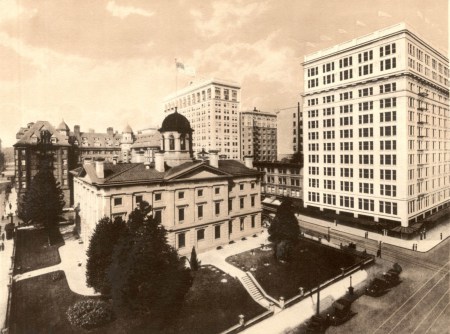
Portland looked every inch the modern, sophisticated city in this 1915 portrait featuring Pioneer Courthouse in the center. The Portland Hotel hosted well-heeled travelers to the west while the American Bank Building and the newly completed portion of the Meier & Frank Building projected wealth and prestige. This view is to the northwest and the intersection at bottom right is SW 5th and Morrison.
1916 Age: 53, 411 1/2 Burnside, Portland, Oregon, USA Broker
Penny Postcard, Postmarked 1916, "Beautiful Homes and Side Walks Lined with Roses, Portland, Oregon.". Published by Lipschuetz Company, Portland, Oregon.
Sixth Avenue, Columbia Theatre on left
1917 Age: 54 411 1/2 Burnside, Portland, Oregon, USA Broker
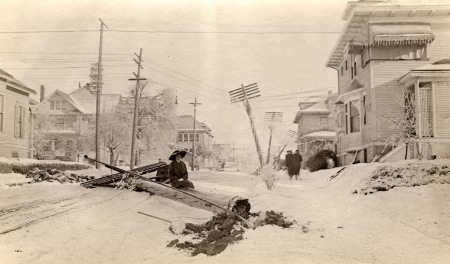
Snow in Portland, 1917 Portland got hit by a surprise snowstorm. NE 19th and Weidler.

Multnomah Hotel Thanksgiving, 1917
1918 Age: 55 22 10th N, Portland, Oregon, USA
Newspapers trumpeted the good news as spontaneous celebrations broke out throughout Oregon after the Armistice took effect on November 11, 1918. (Oregon Journal, November 11, 1918)
Portland took to the streets to celebrate on November 11, 1918.
1919 Age: 56 22 10th N, Portland, Oregon, USA
..Soon after the 11 November armistice ended hostilities, UB-88 surrendered along with the other warships of the High Seas Fleet. They were interned - probably at Harwich, England - on 26 November 1918. When the United States Navy expressed an interest in acquiring several German submarines to be used in conjunction with the current Victory Bond drive and to enable American crews to learn their supposed secrets, UB-88 and five other boats were allocated to the United States with the agreement that they would be destroyed upon the conclusion of the bond campaign.
UB-88 in Portland, Oregon 1919. The UB-88 stopped in Portland before moving on to Bremerton and Seattle.-88 in Portland, Oregon 1919.
UB-88 Portland, Oregon 1919
1920 Age: 57 22 10th N, Portland, Multnomah, Oregon Lodger: 22 10th N Office: Clerk, 1301 Yeon Building
 The Yeon Building is a historic 59.13 m (194.0 ft), 15-story office building completed in 1911 in downtown Portland, Oregon. Almost completely clad in glazed terra-cotta, and culminating in a colonnade on the top floors, the Yeon Building once was illuminated at night by light sockets built into the cornices, but later removed. The building's namesake is Jean Baptiste Yeon (1865–1928), a self-made timber tycoon who financed the construction. At the time of completion, the Yeon Building was the tallest building in Oregon and it remained so for nearly two years. In 1994, the Yeon Building was added to the National Register of Historic Places
The Yeon Building is a historic 59.13 m (194.0 ft), 15-story office building completed in 1911 in downtown Portland, Oregon. Almost completely clad in glazed terra-cotta, and culminating in a colonnade on the top floors, the Yeon Building once was illuminated at night by light sockets built into the cornices, but later removed. The building's namesake is Jean Baptiste Yeon (1865–1928), a self-made timber tycoon who financed the construction. At the time of completion, the Yeon Building was the tallest building in Oregon and it remained so for nearly two years. In 1994, the Yeon Building was added to the National Register of Historic Places
1921 Age: 58 22 10th N, Portland, Oregon, USA Clerk for S. Benson
This photograph was published by the Portland Telegram on August 2, 1921, after local reporters were summoned to the Multnomah Hotel in Portland by an enticing phone message the day before. Upon arriving, the newspapermen entered a room full of some of the most influential men in the city, including the mayor and the chief of police, who had received the same "mysterious" phone call.
The calls were made by members of the Ku Klux Klan and at least two representatives of the Oregon chapter, dressed in the recognizable robes and hoods of Klan members, were on hand. The "Exalted Cyclops" to the right in the photograph was Fred Gifford, a former line superintendent for the Northwestern Electric Company. Gifford was made the Grand Dragon in 1921 in order to recruit new members and gain influence in government. The "nameless officer" in the center of the photograph was "King Kleagle" Luther I. Powell. Powell called the meeting in order to counter the recent negative press against the KKK's illegal activities and to document the supposed collaboration of Klan members and city officials in retaining "law and order."
The civic leaders posing with Powell and Gifford in the photograph, from left to right, are: H.P. Coffin of the National Safety Council; Captain of Police John T. Moore; Chief of Police L.V. Jenkins; District Attorney W[INVALID] H. Evans; U.S. District Attorney Lester W. Humphreys; T.M. Hurlburt, a sheriff; special agent of the U.S. Department of Justice Russell Bryon; Mayor George L. Baker; and P.S. Malcolm, the sovereign inspector general in Oregon for the Scottish Rite Masonic Lodge.
This photograph makes clear how comfortable KKK leaders were in the public spotlight in the early 1920s—despite their supposed anonymity—and how indulged they were by many civic governments, at least for a short time. That night Powell announced, "There are some cases, of course, in which we will have to take everything in our hands. Some crimes are not punishable under existing laws, but the criminals should be punished." He did not elaborate, but the implication was clear: the KKK felt entitled to act outside the law. In a room full of enforcers of the law, Powell and Gifford spoke freely without fear of prosecution.
Klan membership in Oregon grew starting in 1921, with chapters springing up throughout the state. Its brief popularity stemmed, in part, from a general racism against minorities (particularly Chinese and Japanese), anti-Catholicism, and a belief in the enforcement of social morality. Gifford successfully lobbied for anti-Catholic legislationin Oregon during his term as Grand Dragon. The political effectiveness of KKK chapters was due in large part to the relationships its leaders formed with the state's policy makers, law enforcers, and fraternal organizations.
Mayor Baker remained close enough to Gifford to join Governor W. M. Pierce in honoring the Grand Dragon at a "patriotic dinner" in 1923. Pierce was endorsed by the KKK in his 1922 campaign and his success indicated to members a political legitimacy for the Oregon chapters. Whether or not this was the case is unclear. The anti-Catholic and anti-minority legislation passing through the Oregon legislature was broadly reflective of the political and social attitudes of Oregonians in general. It is likely that the KKK benefited from this environment rather than being its main architect. Still, cities like Portland tolerated the Klan's initiation ceremonies and often turned a blind eye to the burning crosses on Mt. Scott and Mt. Tabor.
But some people resisted. In Eugene, a 1921 editorial in theRegister Guard remarked on the KKK parades down the city streets: "We have a cynical notion that such pillow coverings as are used in this way will be chiefly useful for concealing the lack of furnishings in the wearer's attic." Judges and district attorneys across the country were denouncing the illegal acts of Klan members, as well. In the same Telegram article describing the Portland meeting in 1921, small press releases on community censure of Klan activity are listed, almost to refute Powell's assertion that "ninety-five percent of the stories are false."
By the middle of the 1920s, the KKK began to decline in Oregon, and by the end of the 1930s, most of the klaverns had dissolved completely. Many people viewed the KKK as corrupt and had lost faith in its ability to solve social problems. The organization's ideologies, however, are still with us in various forms.
1922 Age: 59 22 10th N, Portland, Oregon, USA Clerk for S. Benson
Raid on China Town Casino, 1922
Brutal “Oregon Boot” Made Oregon State Prison Famous
Named after the warden who invented it, the “Gardner Shackle” eventually caused serious musculo-skeletal damage; many former inmates limped for the rest of their lives as a result of habitually wearing one.
This small article ran in the August 1922 issue of Popular Science
Magazine, demonstrating that the “Oregon Boot” was still in
regular use in the early 1920s. The caption claims it weighs 50
pounds, but that figure is almost certainly a typo or a mistake; the
heaviest one used at the Oregon State Penitentiary was 28 pounds.
(Image: Popular Science)
1923 Age: 60 22 10th N, Portland, Oregon, USA Clerk for S. Benson
Panoramic view of Portland, 1923.
1924 Age: 61 22 10th N, Portland, Oregon, USA Clerk for S. Benson
This photo spread appeared in the Morning Oregonian on Jan. 1, 1924,
introducing the three proposed bridge projects. Although the Ross Island
and Sellwood bridges ended up looking substantially different from these
sketches, the Burnside Bridge did not.
1925 Age: 62 22 10th N, Portland, Oregon, USA Clerk for S. Benson
When the expanded building opened in February 1925, it took up the full width of the block along Stark Street. This later view shows the bank as it looked in 1925 when an expansion project duplicated the existing building and doubled it in size, making it one of the largest and most up-to-date banks in the nation. To the right and to the rear, you can see the corner of the original Bank of California Building, along Stark. Architect A.E. Doyle, who also designed the Meier & Frank Building, the Lipman Wolfe Building, the Central Library and Reed College, was the architect on the U.S. Bank Building.
In this interior view, you can see the bank upon completion in 1925 with a lobby ceiling that is 30 feet high. Casts for the ceramic bas-relief on the ceiling were handcarved. Each square was then hand painted under Doyle’s careful supervision and the ceiling has never been repainted.
|
|
|
|
1926 Age: 63 22 10th N, Portland, Oregon, USA
"Portland is know from coast to coast as one of the best lighted cities in the country." -Forbes Magazine, September 1 1926.
1927 Age: 64 22 10th N, Portland, Oregon, USA
Lots of character in this 1927 photo of the northwest corner of West Burnside and NW Park Avenue. Lots of characters, too; groups of men chatting car repair, a gentleman filling his gas tank, and two men working around a hole in the street at far right. Lots of great signs, too, including “Benson Garage” on the brick wall which can still be seen today.
1928 23 Dec Age: 65 Death Portland, Oregon, USA Burial Portland, Oregon, United States Beth Israel Cemetery and Mauseoleum, 426 SW Taylors Ferry Road
 Timeline
Timeline
Follow the history of the Volga Germans from their migration from Western Europe to their arrival in Portland and assimilation into American society.
German Jews brought artisanal and especially mercantile skills, which by the 1870s they had expanded through familial networks that reached to remote towns in Oregon and Washington. Merchants like Philip Selling or Charles Friendly would import goods from colleagues in San Francisco or even New York, and then send younger brothers to towns like Albany, Eugene, The Dalles, or Walla Walla to open general stores. The older brother at the hub of the operation would then sell the season’s harvest to local wholesale grocers or forward the surplus to the much larger market in San Francisco. Younger cousins, nephews, and brothers-in-law would be apprenticed as clerks in the wholesale operations in Portland. As the railroads made it faster and cheaper to ship manufactured goods, firms like Selling and Akin, Fleischner-Mayer, and smaller operators like Charles Friendly began to specialize in specific lines of merchandise like boots and shoes, men’s clothing, or crockery so they would not compete with one another.
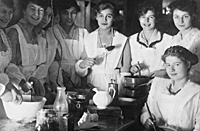
Young Jewish Women in Portland Kitchen
In Portland German Jewish merchants selected housing sites relatively close to the old business core, perhaps to facilitate attendance at Sabbath services and at Sunday school at Temple Beth Israel at Fifth and Oak Streets. By 1880, when gentile merchants were already moving south along Sixth Street and west along Harrison to Eleventh Street, as well as south along Eleventh and Twelfth streets from Alder to Clay, Jews still clustered downtown around Fourth and Washington streets, and in larger numbers west of the Park Blocks in a narrow corridor between Yamhill and Alder.
Postcard depicting the 1889 Temple Beth Israel synagogue, which was destroyed by fire in December 1923
Albina - A New Home in Portland
 The small settlement of Albina is shown to the left of this 1879 map.
The small settlement of Albina is shown to the left of this 1879 map.
The oldest Volga German settlement in Oregon is in the Northeastern part of Portland in what is known as the Albina neighborhood. The settlement dates to 1882 when Volga Germans, after having worked for the Union Pacific Railroad, were either brought to or terminated their employment in San Francisco. From San Francisco they were transported to Portland by ship. In the 1930's this settlement numbered about 500 families.
The Volga German neighborhood was concentrated in an area generally bounded by NE Alberta on the North, NE 15th on the East, NE Russell on the South, and NE Mississippi and NE Albina on the West. This area was known as Rooshian Town or Little Russia by the locals and was the residential area for most families until well into the 1940's. Many of the churches and businesses in this neighborhood were founded or owned by Volga German families.
Williams Avenue was once the fashionable street of Albina and the equivalent of today's shopping mall for the Volga Germans. At that time the road was planked from Russell to Alberta. Later a sandstone brick was put down when the ferry landing was put in at Alberta. Early settlers told stories about how they would zigzag the horses back and forth across the steep hill near the Willamette River.

Photograph of a Volga German family living in Albina during its early days.
Union Avenue (now Martin Luther King Boulevard) later became the heart of the Albina business district and was home to many German-Russian businesses. Before the large chain stores moved into the neighborhood, families patronized local businesses such as Repp Brothers, Hildermann's, Krumbein's, Bihn's, Hergert's, Grenfell's grocery and meat markets, Geist Shoe and Department Store, Trupp Shoe Repair, and Weimer's Hardware and Furniture Store. Other stores were sprinkled throughout the neighborhood such as Danewolf's on NE 13th and Failing and Lehl and Popp on NE 10th and Failing who supplied groceries to the local residents. Store representatives contacted housewives at their homes or orders were phoned for delivery. Pad and pencil recorded each item and clerks retrieved the articles for the customer. After cows and chickens were no longer allowed within the city limits, milk trucks delivered milk to doorsteps. In the early days, children delivered milk in gallon buckets and quart jars to relatives and neighbors.
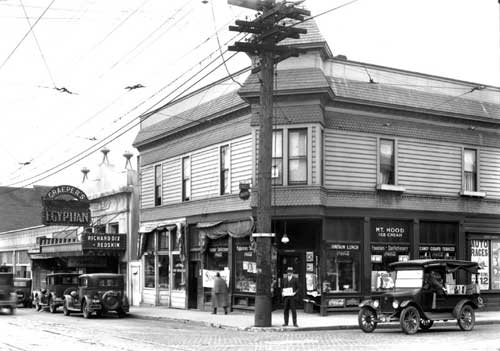
NE Union and Russell. According to Carol Gass (nee Hergert), "this is the very same building that theHergert Tavern was located in, only then there were horses and wagons on the street".
Lower Albina, along Russell Street, was a rough area. Some thirty saloons spread out from the top of the ferry slip to the corner of Russell and Union Avenue. As late as 1929, Albina was connected to Portland via ferry service.
Left: The intersection of Vancouver Avenue and Russell Street in the Albina area of Portland, Oregon (1909).Right: A view of Union Avenue in the early 1900's.
Many remember riding the street cars down Union Avenue to the Jantzen Beach Amusement Park where you could take swimming lessons, visit the haunted house, ride the wooden roller coaster and drive bumper cars.
Albina History
Albina was laid out in 1872 with a plat for the new town filed in April 1873 by Edwin Russell, William Page, and George Williams. Albina was named after Mrs. Albina Page, the wife of William Page. Settlement of the area began in 1874 and the City of Albina was formally incorporated in 1887.
The original dimensions of Albina were modest; from Halsey Street north to Morris Street, and from the Willamette River to Union Avenue (then Margareta Avenue).
Painting by Portland artist J. O. Foster of a house near the Albina Ferry landing in 1896. According to the Portland Art Museum, Foster was an early Oregon artist who specialized in city scapes. He exhibited in the Oregon Industrial Fairs of 1893 and 1895 and with the Portland Sketch Club.
According to Roy E. Roos, author of the book The History of Albina, the town was originally was formed down by railroad tracks in lower Albina along Russell street, the first subdivision was platted in 1873 and extended a residential area to just east of the current Martin Luther King (MLK) Blvd. and north past NE Morris street.
Roos goes on to say that, "The first arrivals were mainly Irish and Germans, separated of course. Then by early 1880s, Scandinavians came who preferred upper subdivisions north of Eliot neighborhood such as along N. Mississippi up to about N. Prescott street. New plats that stretched further out were filed like mad by 1891, even out towards St. Johns past the University of Portland and east of MLK up to Killingsworth, as the Albina city limits expanded. From my findings, most of Russian Germans settled in the area north of Fremont and east of N. Williams Avenue out in the Lincoln Park subdivision (south of NE Prescott street). This area was more sparsely settled early and it is likely the reason they preferred it. The lots were cheaper too."
The construction of the Union Pacific Railway and the terminal yards caused both the population and the property values in Albina to soar. From 1887 until 1891, Albina city ordinances primarily addressed the economic interests of the railroad and other large investors, making it essentially a company town.
Prior to the opening of the Morrison Bridge in 1887, some parts of Albina were uninhabited wetland. However, as transportation from the central district became easier, population in Albina continued to rise, as did land prices, quadrupling in the first decade of the 20th century.
In 1889, Albina annexed the land north to Killingsworth Street and east to 24th. According to the February 15, 1890 Albina Weekly Courier, the city grew rapidly and haphazardly:
"One of the great blemishes of our great city is her short, jagged streets, many of which begin nowhere and end nowhere. The owners of the various additions [to Albina] have laid out their streets regardless of neighboring additions. There are now 25 additions to the original Albina townsite."
In 1891, growth continued as Albina annexed everything north to Columbia Boulevard and west to the Portsmouth area. Most of Albina at that time was unplatted farmland. It is important to note that Albina remained an independent municipality, with the City of Portland being entirely confined to the west bank of the Willamette River.
An 1890's wood engraving antique bookplate map of Portland, Albina and East Portland from a book titled "Topography, History, Geography & Inhabitants of North America - ca. 1895."
To acknowledge the frequent and integral connections between activities on both sides of the Willamette, voters in Albina, East Portland, and Portland were asked in 1891 to vote on measure that would consolidate the three municipalities into one city. The results of the consolidation vote showed 10,126 people in support and 1,714 against the measure. The Oregonian was especially impressed both by the large voter turnout, and by the importance that downtown businessmen placed in the measure.
With the consolidation measure approved, Portland’s land area increased to twenty-six square miles and its population grew to at least 63,000. At the time of consolidation in July 1891, Albina’s land area covered thirteen and a half square miles including St. Johns, more land than Portland and East Portland combined.
Just days before Albina’s planned incorporation into the city of Portland was finalized, Albina’s city council hurriedly passed ordinances and signed contracts for such expenditures as paved roads, city parks and lighting, which benefited property owners but created a financial burden for the taxpayers of the newly combined city.
The streets in Albina were laid out in the "Philadelphia pattern" with numbered street paralleling the Willamette River and named streets running east-to-west. Many street names were changed in 1891 because of duplication in the three consolidated cities. Another major street plan change was made in 1931 which created the system now used in Portland. This system established 100 numbers to the block and five geographic regions (N, NE, SE, NW, and SW). Portland's address style that places the geographic designation between the house number and street name (rather than following the street name as in Seattle) was also established at this time.
By 1910, the population on the east side of Portland reached 120,000.
The ethnic settlements map is from E. Kimbark MacColl's book The Shaping of the City, p.463. MacColl credits the sources as a Portland Public Schools Annual Report, and Ethnicity in Portland, 1859-1970, A Brief Demographic History to be published in 1976 by the Center for Urban Education. The German-Russian population circa 1910 is indicated on the map by the circled number 8.
Over time, many of the neighborhoods in North and Northeast Portland were considered part of the Albina Area.
Family Lines____________________________________________________
Wife: None Known
Father: Davis (David) Rosenthal (1829 - 1901)
Mother: Augusta Goldman (1843 - 1923)
Children: None Known
Siblings:
Benjamin Rosenthal (twin) (1869 - 1916)
Joseph Rosenthal (twin) (1869 - ??)